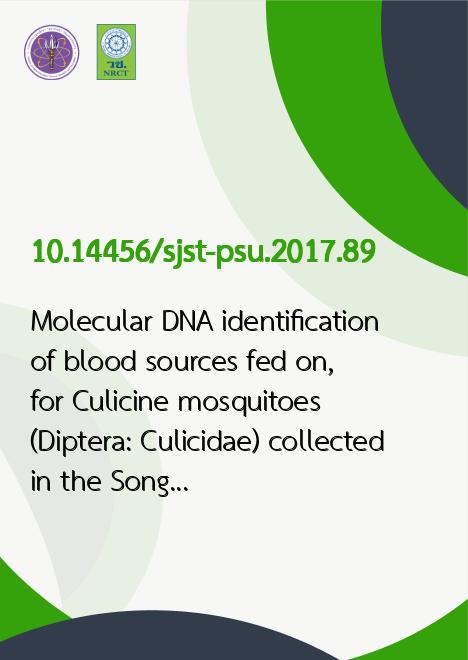
|
Molecular DNA identification of blood sources fed on, for Culicine mosquitoes (Diptera: Culicidae) collected in the Songkhla province, southern Thailand |
|---|---|
| รหัสดีโอไอ | |
| Creator | 1. Theerakamol Pengsakul 2. Napadol Sudsom 3. Gregory Foakes 4. Kartik Bhatt 5. Marisa Eisenberg 6. Padet Siriyasatien |
| Title | Molecular DNA identification of blood sources fed on, for Culicine mosquitoes (Diptera: Culicidae) collected in the Songkhla province, southern Thailand |
| Publisher | Research and Development Office, Prince of Songkla University |
| Publication Year | 2560 |
| Journal Title | Songklanakarin Journal of Science and Technology (SJST) |
| Journal Vol. | 39 |
| Journal No. | 6 |
| Page no. | 731 |
| Keyword | cytochrome b gene,multiplex PCR,Aedes spp.,Culex spp.,blood meal |
| ISSN | 0125-3395 |
| Abstract | Culicine mosquitoes are medically important vectors. Therefore, mosquito control measures are a crucial strategy tointerrupt disease transmission. Collection of data on mosquito feeding patterns is crucial for developing an effective vectorcontrol strategy. The objective of this study was to use molecular biology methods to identify the sources of DNA inmosquito blood meals. The DNA from blood meals in the mosquito stomachs was extracted and amplified with multiplex PCR,using specific primer sets based on the mitochondrial cytochrome b gene, to identify the DNA sources among human, pig,goat, dog, cow, and chicken. Among the 297 mosquito samples collected in the Songkhla province of Thailand, in Aedes spp.mosquitoes the percentages positive for human, dog, pig, chicken, cow, a mixture of 2 vertebrate DNAs, or of 3, and negative(no identified DNA) were 61.90, 2.38, 2.38, 0.60, 0.60, 4.18, 1.20 and 26.79% respectively. In Culex spp. blood meals the rankorder was different: fractions positive for chicken, human, dog, cow, goat, pig, a mixture of 2 or 3 vertebrate DNAs, andnegative were 40.83, 10.00, 5.00, 4.17, 1.67, 0.83, 8.32, 3.32 and 25.83% respectively. This study shows that feeding behaviorsof the two species differ, with most Aedes spp. blood meals containing human blood, while Culex spp. had primarily consumedchicken blood. An improved understanding of the feeding behaviors of mosquitoes could contribute to new, more effectivestrategies for the control of mosquito populations. |
